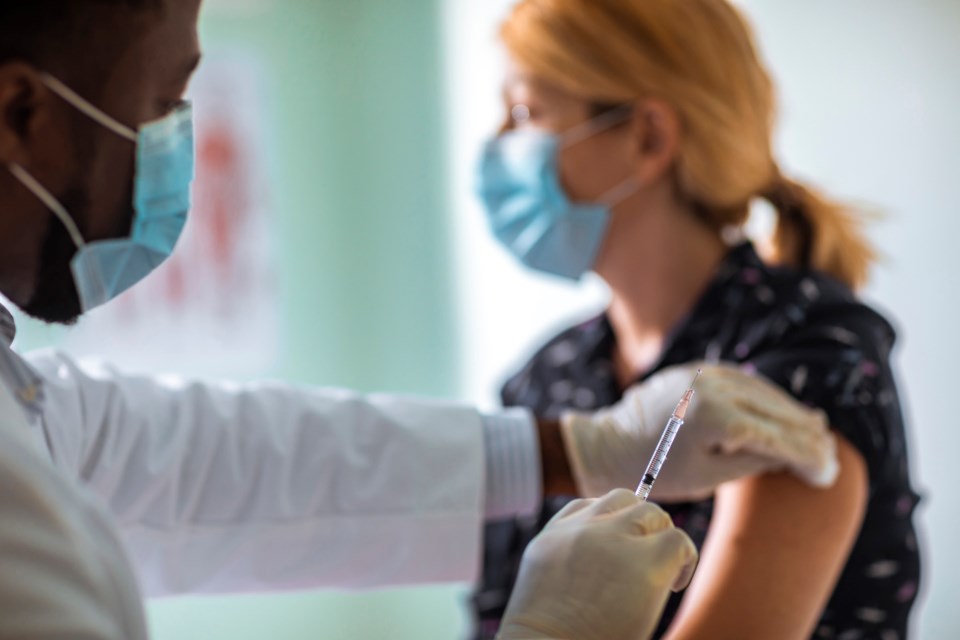The head of the Northwestern Health Unit says the agency is looking to address vaccine hesitancy, as spots go unfilled at vaccine clinics and coverage rates lag behind other areas of the province.
Data released Tuesday shows vaccine uptake among seniors in the NWHU is nearly 10 per cent lower than in the neighbouring Thunder Bay District Health Unit (TBDHU), for example.
Medical officer of health Dr. Kit Young Hoon has expressed concerns over lower-than-expected uptake in some areas of the health unit. At a press conference Tuesday, she said that the NWHU was working to understand what was behind that.
“In general, we’re looking at it and exploring it locally to get a better sense of how best to address the low coverage rates,” she said. “We’re hopeful that people are just needing more time.”
Young Hoon urged anyone 12 and over to book their vaccine appointment, repeating the message that COVID-19 vaccines are safe and effective.
She pointed last week to only “moderate” uptake after the province opened bookings to those 18 to 40, with a number of vaccine clinics not fully booked.
That led the health unit to begin offering walk-in clinics in areas with unfilled spots.
Young Hoon said Tuesday those open clinics had been successful, and the NWHU would continue to offer both walk-in and booked clinics as long as spots were not filling up.
A total of 45,882 vaccine doses had been administered as of Tuesday in the health unit, which has an estimated population of 82,231.
Of the vaccine-eligible population aged 12 and older, 57 per cent have received at least a first dose. That works out to 44 per cent of the entire population, compared to 50 per cent in the TBDHU.
The difference is most striking among older demographics.
NWHU residents 80 and older lag more than 10 per cent behind those in the Thunder Bay District Health Unit, and the provincial average, with only 74.2 per cent having received at least a first dose in data released Tuesday.
That figure was at 85.9 per cent for the TBDHU, and had already topped 85 per cent province-wide as of May 15, according to Public Health Ontario.
In the 70 to 79 age group, the NWHU’s coverage of 77 per cent compared to 86.4 per cent in the TBDHU.
In the 60 to 69 age group, 73.7 per cent had received a dose in the NWHU, compared to 80.6 per cent in the TBDHU.
Vaccine coverage numbers were higher in the NWHU than the TBDHU for age categories under 50, though Young Hoon expressed concern over recent uptake in that demographic as well last week.
Vaccination numbers vary wildly across the health unit, which covers nearly one fifth of Ontario’s land mass.
In the Dryden hub, 64.3 per cent of residents 12 and up have received at least a first dose, with the Fort Frances and Kenora hubs also topping 60 per cent.
In other areas, fewer than 40 per cent of residents had gotten a jab, with the Emo hub at 38.9 per cent and the Red Lake hub at 39.3 per cent.
“It’s really challenging to know what is the true cause for those differences in vaccine coverage,” said Young Hoon. “We cover a large geography, and in some of the health hubs there are different cultural norms or attitudes towards vaccines. We’re monitoring the coverage rates across the different health hubs, and we’ll be trying to specifically address the concerns that are out there.”
Health authorities were looking to understand barriers that might be holding some back from getting the vaccine, Young Hoon said, but she believes misinformation spread over social media could be a major cause.
On Tuesday, she reiterated emphatically that vaccines were safe and effective.
“The vaccines that are being administered are safe – they’ve gone through a rigorous research and evaluation process by both Health Canada and the National Advisory Committee on Immunizations,” she said. “They’re shown to be safe. The side effects that one may experience generally are symptoms that will go away quickly and have no long-term effects.”
That message may have more resonance coming from sources closer to home, she acknowledged, saying the health unit would consider strategies like working with community leaders and groups to get the message out.
Individuals can also play a helpful role by reaching out to those in their own social circles.
“Trying to address vaccine hesitancy is very challenging,” she said. “People often listen to someone they know and trust, so we do encourage individuals to reach out to friends and family and explain to them why you chose to get vaccinated, and where they can go to get reliable information about the vaccine.”
The health unit’s website includes links to a number of resources with vaccine information.
The issue of vaccine coverage goes beyond individual health, Young Hoon noted. A new provincial “roadmap to reopening” requires 70 to 80 per cent of adults to have received at least a first dose before reaching the final stage of reopening, which would allow indoor gatherings of more than five people and more.
“Vaccination is key from a provincial perspective with respect to lifting some of the public health restrictions that are currently in place,” said Young Hoon.
